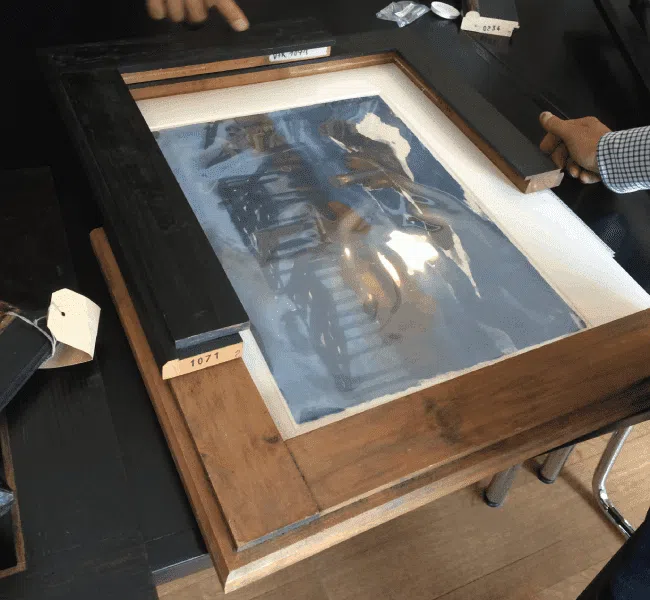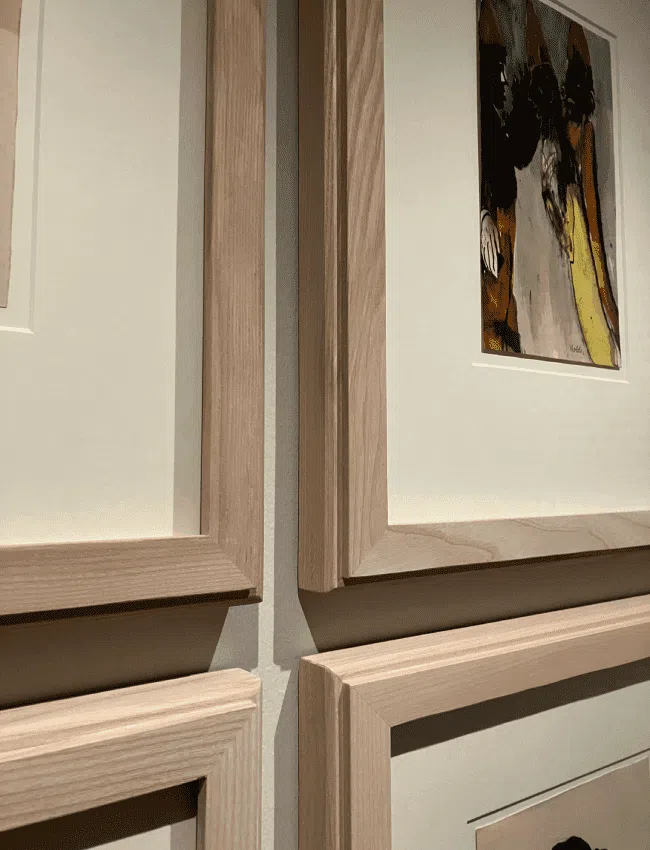Discover Emil Nolde: A look behind the scenes
The year 1910 was of enormous significance for the artists' association "Brücke". Its exhibition at the Arnold Gallery in Dresden in September of that year documented a changed view of art - paintings and frames were seen as a unit. With a few exceptions, simple frame profiles replaced the pompous frames, which were often heavier than the artworks themselves. The new formal language in painting also demanded a new type of framing. Emil Nolde once described the gilded plaster frames as "somewhat reprehensibly inauthentic". And so it was that the artists set about designing the frames themselves and in some cases building them themselves. The result was a compositional unity in which the colour, materiality and production technique of the frames merged with the paintings and became an integral part of them. Always in the spirit of Expressionism and in keeping with the idea of the painting. However, what the artists saw as an inseparable part of their work became less and less recognised over the decades. The simple frames were often replaced by more ornate frames and were often no longer even mentioned in a scientific context.
The Munich frame expert Werner Murrer dedicated himself to these frames and began to systematically record the frames of the "Brücke" artists a good 30 years ago and save them from oblivion. For this task, he and his team researched countless archives, catalogues and exhibitions and created a database with over 130,000 photos, among other things.
Art historian Astrid Becker is deputy director of the Seebüll Ada and Emil Nolde Foundation. On the occasion of the 68th annual exhibition entitled: "Emil Nolde - Fantasies" (Fig. p.16/17), we went in search of traces of the new "Nolde Leiste" with both of them.

Dr. Astrid Becker
She is deputy director of the Seebüll Ada and Emil Nolde Foundation and is passionate about preserving, researching and communicating Nolde's work.

Werner Murrer
He has been an accomplished and passionate frame maker in Munich for over 30 years and is considered the most important expert on Expressionist frames.
Tip:
WERNER MURRER RAHMEN in search of original frames on Instagram:
@werner_murrer_rahmen
What prompted the Nolde Foundation Seebüll to have new frames made?
A.B.: Emil Nolde is one of the most famous Expressionists, who was also a member of the Brücke for a short time. He regarded the frames as an integral part of the artwork; pictures and frames became an inseparable compositional unit. The Nolde Foundation Seebüll had an extensive stock of removable frames for works on paper from the very beginning. However, these had been in use for many decades and were now somewhat outdated. We wanted a removable frame that was more practical in terms of art handling and safer for the art and at the same time reflected the "spirit of Nolde".
How did the design of the new "Nolde-Leiste" come about?
A.B.: In 2015, the first thoughts began to revolve around new removable frames. By chance, we got in touch with Werner Murrer, who wanted to deepen his knowledge of Nolde for an exhibition and visited our archive for this purpose. Although we knew Nolde's typical frames, we wanted support from an expert in Expressionism and framing techniques.
W.M.: Yes, that's right. I was in Seebüll a few times and we got into a conversation, and also talked a lot about the frames.
What thoughts or research were necessary for this?
A.B.: It was and is important to us that every centimetre of the site in Seebüll breathes the spirit of Nolde. We also attached great importance to the original design idea when remodelling the Nolde House. Together with Werner Murrer and our carpenter Hans-Jürgen Christiansen, we developed an interchangeable frame for the new "Nolde moulding" that picks up on the typical features of Nolde's frame - the stepped profile and the striking chamfer (Fig.01 ). The aim was to reflect an expressionist style and at the same time to design a frame that was wide and high enough to adequately protect and present the artworks.

©Nolde Stiftung Seebüll
W.M.: : This led to a first draft in 2016, based on our research into Nolde. We collected a lot of material for the "Inseparable" exhibition over time and were able to draw on it, which is why a suitable design quickly emerged. The drawing of the first moulding was based on a typical original frame (Fig. 02 + 03). Striking and at the same time simple - typical of Nolde and Expressionism.
A.B.: Fortunately, in addition to WERNER MURRER RAHMEN WERNER MURRER RAHMEN, we were also able to get HALBE-Rahmen for our project. The integration of a HALBE frame as an interior frame enables a wonderful connection between Nolde's aesthetics and the highest conservation standards. The principle, which has already proved its worth in the Munch Museum in Oslo and the Van Gogh Museum in Amsterdam, seemed to us to be ideally suited to our wishes and requirements. We therefore decided in favour of the CONSERVO-DISTANCE because the framing is easy to handle and there is no direct contact between the artwork and the glass. The question of the ideal sizes was also exciting for us. Emil Nolde created works on very different paper formats, and the new removable frames should be able to cover all sizes in a sensible and manageable way. To this end, our team analysed the entire collection, which was quite a challenge given its size.

©Nolde Stiftung Seebüll

©Nolde Stiftung Seebüll
What is special about the frames?
A.B.: The beauty of the interchangeable frames is the combination of easy handling, which is gentle on the artwork, and a "Nolde strip". We don't have to turn or rotate the works on paper first, but can insert everything from the front. Frame, insert the glass, secure - done. Nolde's aesthetics were also important to us. The inner frame is covered by a wooden frame, which was made by our carpenter Hans-Jürgen Christiansen (Fig.04) to a design by Werner Murrer and is entirely in the spirit of Nolde. Currently, the decorative frames are made of natural ash, because the color of the wood is more subtle (Fig.05). Our extensive collection of works on paper requires a large number of wooden frames. But that did not deter our Mr. Christiansen. He just said to me with a smile: "We'll get it right."

©Nolde Stiftung Seebüll

©Nolde Stiftung Seebüll
When were the new frames shown for the first time?
A.B.The extensive framework project was realized in parallel with the renovation of the Nolde House. The refurbishment took place from January 2020 to August 2022. The Nolde House was technically upgraded and carefully restored to its 1937 condition. In August 2022, the renovated Nolde House was once again open to the public - without art, only the architecture was effective. In March 2023, we not only presented the first art exhibition in the renovated residential and studio building, but also the new interchangeable frames. The new frames are the icing on the cake for a Nolde experience in the Seebüll Gesamtkunstwerk. Both were really two special moments for the foundation. I am still delighted that everything has come together in the spirit of Emil Nolde. This year, the removable frames will also go on loan for the first time.
Anyone who would like to marvel at the unity of picture and frame for themselves is cordially invited to visit the 68th annual exhibition at the Nolde Museum Seebüll, which will take place from March 1 to October 31, 2024 under the title "Emil Nolde - Fantasies" (Fig.06). It sheds light on an aspect of the artist's work that has received little attention to date. The focus is on his spontaneous and unconsciously created works, in which he depicted curious and sometimes ghostly creatures on canvas and paper. Nolde saw nature as animated by fantastic creatures and found inspiration for his fantastic depictions particularly in the German-Danish border region. The exhibition places these fantasy figures in a dialog with Nolde's famous works from the genres of flower garden, landscape, seascape and figure painting. The late "Unpainted Pictures" in particular show Nolde's unbridled creativity and close the circle of his fantastic works.

©Nolde Stiftung Seebüll
Visitors are invited to indulge in their own dreams and fantasies and explore Nolde's world "beyond rules and cool knowledge". With around 120 masterpieces from the museum's collection, the exhibition offers a deep insight into Nolde's oeuvre and underlines the relevance of his work for the present day, especially for lovers of fantasy worlds.
Contact:
www.nolde-stiftung.de
Instagram: @nolde.museum.seebuell